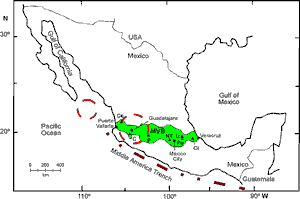 |
|
The
Gulf of California and Mexican Volcanic Belt
|
|
|
| It
has been suggested that mantle plumes underlie the mouth
of the Gulf of California and the Mexican volcanic belt
(Figure 1). Rifting began in the Gulf around 5.5 Ma
with seafloor spreading beginning around 3.5 Ma. The
notion of a Gulf Mouth hotspot derives from models that
propose plumes to be the cause of continental break-up.
Volcanism in the Mexican volcanic belt occurred from
about 16 Ma to the present and includes subalkaline
and alkaline magmas. The presence of a plume has been
inferred from beliefs that alkaline volcanism is diagnostic
of plume activity, and possible west-east age progressions
[Moore et al., 1994]. Whether volcanism in
both regions could be attributed to a single plume has
not been addressed. The argument presented here is that
there is no evidence and no requirement for any plumes
in the region. |

Figure 1: The Mexican Volcanic Belt (MVB) and
regions where plumes have been proposed (dashed red
circles). Major volcanoes are shown by filled triangles:
C = Colima; Ce = Ceboruco; P = Paricutín; NV
= Nevado de Toluca; Po = Popocatépetl; Iz =
Iztaccíhuatl; Ci = Citlaltépetl (Pico
de Orizaba).
|
| The arrival
of a plume is predicted to cause uplift, enhanced magmatism
and distinct geochemical signatures. A Deep Sea Drilling
Project transect (Legs 64 and 65) sampled the basaltic
volcanism in the Gulf Mouth region. The basalts are
MORB-like with no evidence for excessive magma production,
and isotopic compositions can be explained in terms
of normal mantle heterogeneity with some contamination
of melts during the early stages of rifting by interaction
with the continental mantle [Smith, 1999]. |
| In the Mexican
volcanic belt, there is no evidence for uplift, regular
age progressions are not well developed, and an extensional
tectonic regime exists all along the belt [Sheth et
al., 2000; Verma, 2002]. The location and
orientation of the belt is also inconsistent with a relationship
to subduction of the Cocos plate [Verma, 2002].
Rather, the association of alkaline and subalkaline volcanism
can be explained as a result of a rifting induced by large-scale
plate interactions, leading to melting of a heterogeneous
continental mantle section [Sheth et al., 2000]. |
| References
- Moore, G., C. Marone, I.S.E. Carmichael, and P.
Renne, Basaltic volcanism and extension near the intersection
of the Sierra Madre volcanic province and the Mexican
volcanic belt, Geol. Soc. Am. Bull., 106,
383-394, 1994.
- Sheth, H.C., I.S. Torres-Alvarado, and S.P. Verma,
Beyond subduction and plumes: A unified tectonic-petrogenetic
model for the Mexican volcanic belt, Int. Geol.
Rev., 42, 1116-1132, 2000.
- Smith, A.D., The Nd-Sr-Pb isotopic record in abyssal
tholeiites from the Gulf of California region, western
Mexico: No evidence for a Gulf Mouth plume, Int.
Geol. Rev., 41, 921-931, 1999.
- Verma, S.P., Absence of Cocos plate subduction-related
basic volcanism in southern Mexico: A unique case
on Earth?, Geology, 30,
1095-1098, 2002.
last updated 7th June, 2004 |
|
|
